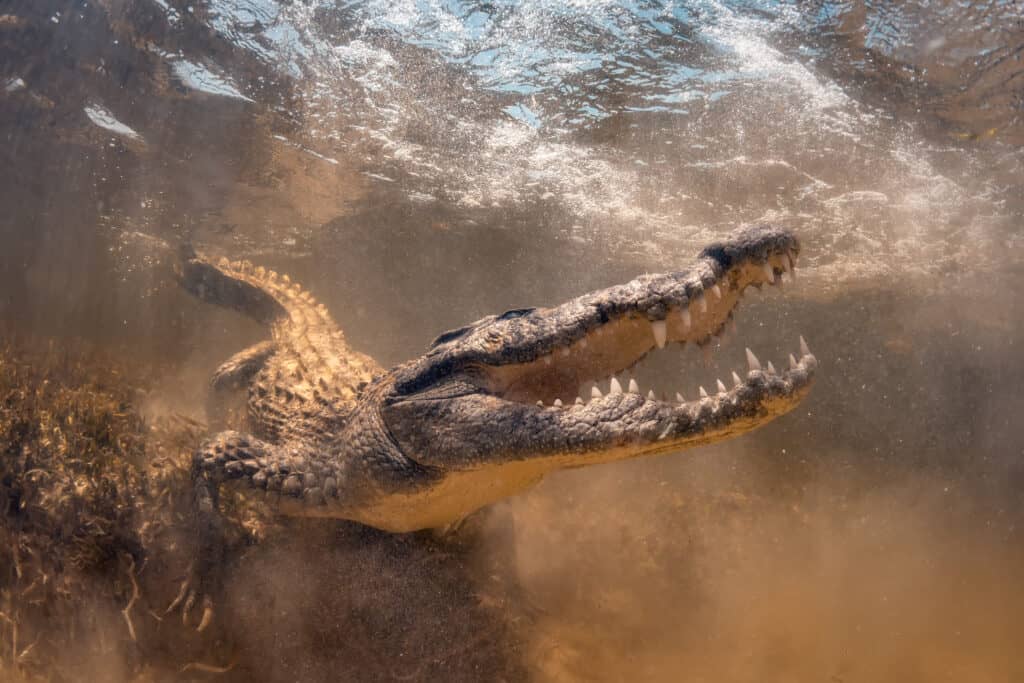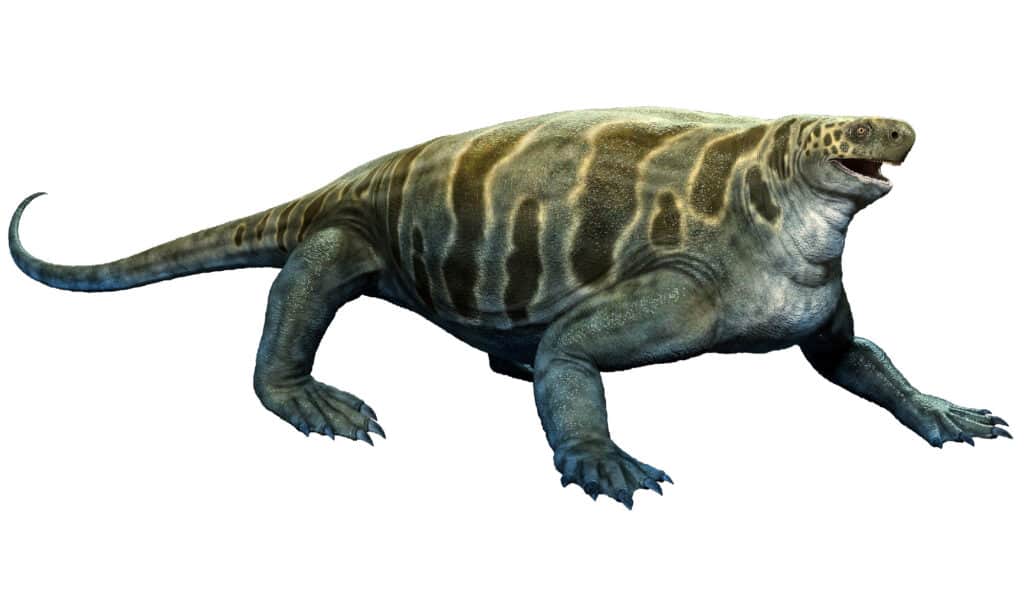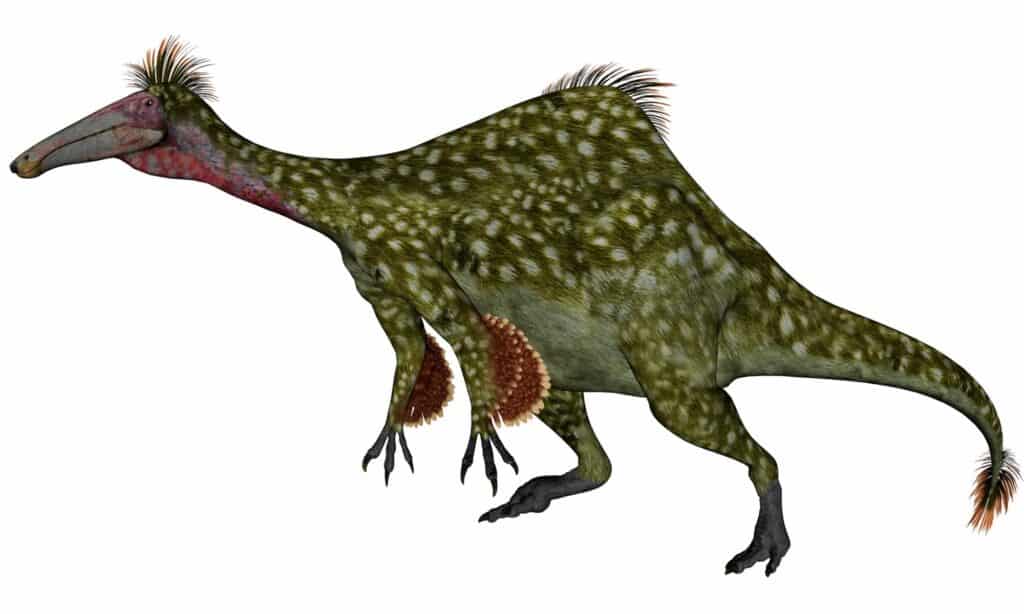
One of the largest animals on the planet is the enormous crocodile. From the tiny dwarf crocodile to the saltwater crocodile, size varies widely between species. The saltwater crocodile can reach adult sizes of over 6 m (20 ft) and weigh over 1,000 kg (2200 lb.). Species of the dwarf crocodile Osteolaemus only reach adult sizes of 1.5 to 1.9 m (4.9 to 6.2 ft). Other species can grow over 5.2 meters (17 feet) long and weigh more than 900 (2,000 lb.). In this article, you will learn about five enormous reptiles bigger than crocodiles.
Male crocodilians grow significantly larger and more quickly than female crocodilians, who exhibit pronounced sexual dimorphism. Crocodiles begin their life at a length of about 20 cm (7.9 in) despite growing to enormous adult sizes. The saltwater crocodile, which is the largest living reptile species, lives in the surrounding waters of Eastern India, Northern Australia, and Southeast Asia.

Saltwater crocodiles can reach sizes of up to 20 feet in length and weigh 2,200 pounds.
©Alexander Machulskiy/Shutterstock.com
A saltwater-Siamese hybrid known as Yai (Thai: meaning enormous; born 10 June 1972) lives at the Samutprakarn Crocodile Farm and Zoo in Thailand. Yai is the largest crocodile ever kept in captivity. This animal is 6 meters (20 feet) long and 1,200 kilograms in weight (2,600 lb.). Lolong, a saltwater crocodile that measured 6.17 m (20.2 ft) and weighed 1,075 kg (2,370 lb.) in Agusan del Sur Province, Philippines, was the longest crocodile ever collected alive. Let’s examine three giant reptiles known to be bigger than crocodiles!
1. Cotylorhynchus

Cotylorhynchus is an extinct species of the synapsid clade Caseidae.
©iStock.com/Warpaintcobra
The Cotylorhynchus was a massive animal (and one of the largest synapsids). It had a disproportionately small head and a gigantic barrel-shaped body. It was technically not longer than a full-grown crocodile. However, the bigger species, C. hancocki, could reach lengths of 6 m (20 ft), while the lesser species, C. romeri, could only reach lengths of 4.5–4.8 m (14.7–15.7 ft).
Dimetrodon was the most well-known pelycosaurs, a short, stocky, four-legged, and neurologically limited Permian reptile often mistaken for a dinosaur. Cotylorhynchus, a less well-known pelycosaur, would have weighed up to two tons, making it much heavier than the crocodile but shorter than it. Turtles, tortoises, and terrapins are the only surviving reptiles that are even distantly related to Cotylorhynchus, Dimetrodon, and the other pelycosaurs, which went extinct 250 million years ago.
2. Deinocheirus Mirificus

Deinocheirus’s vertebrae contained elongated neural spines that constructed a sail along its back.
©iStock.com/Elenarts108
A unique ornithomimosaurian, Deinocheirus was the largest of its group at 11 m (36 ft) in length and 6.5 t in weight (7.2 short tons). Despite being a large animal, it was lighter due to its many hollow bones. The 2.4 m (7.9 ft) long arms were among the longest of any bipedal dinosaur, with three fingers and huge, blunt claws. The legs had blunt claws and were rather short. Tall neural spines on its vertebrae created a “sail” down its back. Pygostyle-like vertebrae near the end of the tail suggest the existence of a fan of feathers. The skull measured 1.024 m (3.36 ft) in length and resembled those of hadrosaurs. This is because it had a broad bill and a deep lower jaw.
Paleontologists found a pair of ominous-looking arm fossils in the Gobi Desert of Mongolia, which served as the creature’s first remains. But it wasn’t until Young-Nam Lee and his team of paleontologists finally found a complete skeleton in 2014 that it became clear what these creatures looked like. The Deinocheirus was an ostrich-like ornithomimosaurian almost as tall as a T. rex. It had a slender, powerfully built body. Despite its fearsome arms, which appear carnivorous, it mostly consumed plants, fish, and tiny animals.
3. Spinosaurus Aegyptiacus

weighed roughly 4000 kg (almost 9,000 lb.) and measured close to 60 feet!
©Noiel/Shutterstock.com
This terrifying prehistoric reptile lived in water, and researchers think it preyed on extinct crocodiles. Because animals would have to keep a sharp eye out for this creature on land or in the water, the Spinosaurus was a most effective predator. Scary, huh? Nevertheless, exciting! It weighs roughly 4000 kg (almost 9,000 lb.) and measured up to 18m long (almost 60 feet)!
In addition to being the scariest predator, this makes it one of the largest reptiles from ancient times. Therefore, a Spinosaurus is a fantastic choice if you’re considering what kind of dinosaur to bring to your next dino-themed party! The Aegyptiacus had a body mass of 7.4 metric tons (8.2 short tons) and a length of 14 meters (46 feet). Like a modern crocodilian, Spinosaurus had a long, low, and thin cranium with straight conical teeth that had no serrations.

The crocodile is the largest living reptile.
©Audrey Snider-Bell/Shutterstock.com
Alligators and Crocodiles
- Alligator: Unlike the crocodile, which prefers saltwater or brackish water, the alligator prefers fresh water. They also have a different snout shape – wider and u-shaped. An alligator lives an average of up to 50 years in the wild.
- Dwarf Crocodile: This is the smallest of the crocodile species and only grows to 5 feet long. They have a long lifespan, with a range of 50 to 100 years.
- Nile Crocodile: This crocodile can reach up to 20 feet in length and prefers freshwater over its saltwater relative. They have an average lifespan of 50 to 60 years in the wild.
- Freshwater Crocodile: Like the Nile Croc, this reptile can be found in freshwater, although they reside in the waters of Australia instead of Africa. Living between 40 to 60 years in the wild, this crocodile is also the fastest of the species.
Summary of 3 Monster Reptiles Larger Than a Crocodile!
| Rank | Reptile | Weight | Length |
|---|---|---|---|
| 1 | Cotylorhynchus | 730 lbs. | 20 feet |
| 2 | Deinocheirus Mirificus | 7.2 short tons | 36 feet |
| 3 | Spinosaurus Aegyptiacus | almost 9,000 lbs. | almost 60 feet |
In Conclusion
The original intent of this article was to discover monstrous “lizards” that were larger than crocodiles. However, upon deep investigation, none were discovered. This finding alone is interesting! Therefore, the article was expanded to consider all reptiles that were truly larger than crocodiles. Clearly, all of them are prehistoric, as there are no known living reptiles larger than the crocodile!
The photo featured at the top of this post is © Mari Swanepoel/Shutterstock.com
Sources
- Wikipedia, Available here: https://en.wikipedia.org/wiki/Evolution_of_reptiles
- Wikipedia, Available here: https://en.wikipedia.org/wiki/List_of_largest_reptiles
Thank you for reading! Have some feedback for us? Contact the AZ Animals editorial team.






